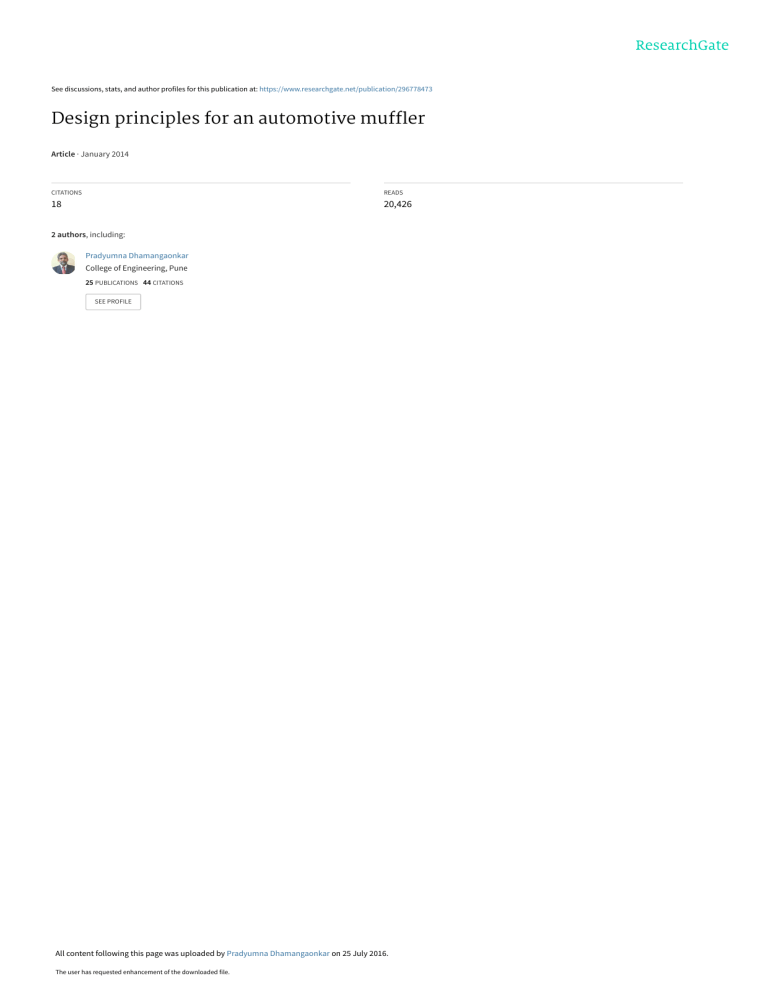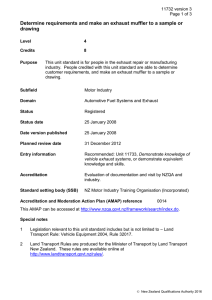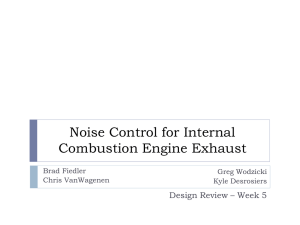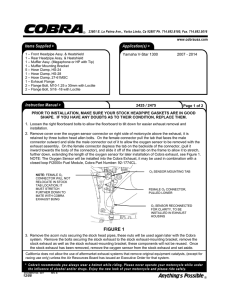
See discussions, stats, and author profiles for this publication at: https://www.researchgate.net/publication/296778473 Design principles for an automotive muffler Article · January 2014 CITATIONS READS 18 20,426 2 authors, including: Pradyumna Dhamangaonkar College of Engineering, Pune 25 PUBLICATIONS 44 CITATIONS SEE PROFILE All content following this page was uploaded by Pradyumna Dhamangaonkar on 25 July 2016. The user has requested enhancement of the downloaded file. International Journal of Applied Engineering Research ISSN 0973-4562 Volume 9, Number 4 (2014) pp. 483-489 © Research India Publications http://www.ripublication.com Design Principles for an Automotive Muffler Vinod Sherekar1 and P. R. Dhamangaonkar2, 1 PG Scholar, Mech. Engg., College of Engineering Pune, Maharashtra, India 2 Mech. Engg., College of Engineering Pune, Maharashtra, India Abstract Mufflers are important part of engine system and commonly used in exhaust system to minimize sound transmissions caused by exhaust gases. Design of mufflers is a complex function that affects noise characteristics, emission and fuel efficiency of engine. Therefore muffler design becomes more and more important for noise reduction. Traditionally, muffler design has been an iterative process by trial and error. However, the theories and science that has undergone development in recent years has given a way for an engineer to cut short number of iteration. This paper discusses the various functional requirements of automotive muffler like Insertion loss, Size of muffler, Backpressure, Cost and Weight. The objective of this study is to give general design guidelines for designing various parameters of muffler. This paper suggests suitable guidelines for selection of muffler grade, muffler length and diameter, Tail-pipe length according to engine cubic capacity and calculation of pressure drop in muffler on the basis of exhaust gas flow rate. It also explains the checking criteria for suitability of muffler for particular application. Keywords: Back pressure, Insertion loss, Muffler, Tail-pipe, Introduction Internal combustion engines are generating the acoustic pulse by the Combustion process. This noise is controlled through the use of silencers and mufflers. A silencer has been the traditional name for noise attenuation devices, while a muffler is smaller, mass-produced device designed to reduce engine exhaust noise. Continuous development has been made in improving performance of the silencers used for automotive exhaust systems. Exhaust mufflers are widely employed to muffle the noise of an engine body or the noise of other predominant sources in vehicles. In order to maintain a desired noise and comfortable ride, the modes of a muffler need to be analyzed. The intensity and magnitude of the noise will vary greatly depending 484 Vinod Sherekar and P. R. Dhamangaonkar upon engine type i.e. naturally aspirated or turbocharged, horse power developed, means of scavenging, type of fuel used, number of cycles whether 2 cycle or 4 cycle engine etc. Basic requirement of muffler design There are various requirements that should be considered when designing a muffler for a automotive application. Such functional requirements may include adequate insertion loss, backpressure, size, durability, desired sound, cost, weight,compact shape and style.Some of them requirements are given in detailed below. Adequate Insertion Loss(IL): An effective muffler will reduce the sound pressure of the noise source to the required level. In the case of an automotive muffler the noise in the exhaust system, generated by the engine, is to be reduced.A mufflers performance or attenuating capability is generally defined in terms of insertion loss or transmission loss. Insertion loss is defined as the difference between the acoustic powers radiated without and with a muffler fitted. The transmission loss is defined as the difference (in decibels) between the sound power incident at the entry to the muffler that of the transmitted by muffler.The muffler designer must determine the required insertion loss so that a suitable type of muffler can be designed for the automotive application. [1,2] Selection of size: The proper selection and sizing of the silencer is of utmost importance to ensure that pressure drop, acoustical performance and other specific design criteria are met. The selection of the correct type of engine exhaust silencer is determined by the type of engine, the end use of the engine and the degree of silencing required. Also, the silencer size selected must accommodate the specified volume of exhaust gas flow keeping the back pressure within the limits specified. The available space has a great influence on the size and therefore type of muffler that may be used. A muffler may have its geometry designed for optimum attenuation however if it does not meet the space constraints, it is useless. [2] Backpressure: Backpressure represents the extra static pressure exerted by the muffler on the engine through the restriction in flow of exhaust gasses. Generally the better a muffler is at attenuating sound the more backpressure is generated. In a reactive muffler where good attenuation is achieved the exhaust gasses are forced to pass through numerous geometry changes and a fair amount of backpressure may be generated, which reduces the power output of the engine.Backpressure should be kept to a minimum to avoid power losses especially for better performance of vehicle. [3] Cost and Weight: Generally the larger a muffler is, the more it weighs and the more it costs to manufacture. For a performance vehicle every gram saved is crucial to its performance.Effectively supporting a muffler is always a design issue and the larger a muffler is the more difficult it is to support. A Muffler’s mounting system not only needs to support the mufflers weight but it also needs to provide vibration isolation so Design Principles for an Automotive Muffler 485 that the vibration of the exhaust system is not transferred to the chassis and then to the passenger cabin. This vibration isolation is usually achieved with the use of hard rubber inserts and brackets that isolate or dampen vibration from the muffler to the chassis. Therefore small light weight muffler is desirable [4]. Design parameters of muffler Selection of muffler grade: There are following exhaust muffler gradesavailable and one can choose according to required insertion loss and specific requirement. The procedure for selection of muffler grade is also explained below:[5, 6] Industrial/Commercial: IL Body/Pipe Length/Pipe = 15 to 25 dBA = 2 to 2.5 = 5 to 6.5 Residential Grade: IL Body/Pipe Length/Pipe = 20 to 30 dBA = 2 to 2.5 = 6 to 10 Critical Grade: IL Body/Pipe Length/Pipe = 25 to 35 dBA =3 = 8 to 10 Super Critical Grade: IL Body/Pipe Length/Pipe = 35 to 45 dBA =3 = 10 to 16 Step-1: Unsilenced noise level (e.g. UNL=104 dB@1m) The overall noise level from most unsilenced engine exhaust systems varies from about 100 dBA to 120 dBA, when measured 1 meter from the pipe outlet. Step-2: Calculate exhaust noise criteria [6] ENC= RNC – 5 (dBA) (1) (E.g. To meet a noise level of 65 dBA,design a muffler for 60 dBA) Step-3: To calculate the unsilenced exhaust noise at the receiver location. The following equation provides a correction for distance assuming free-field spreading.[6, 7] Lp (Xr) UNL= Lp (Xo) – 20 log (Xr/ Xo) (2) 486 Vinod Sherekar and P. R. Dhamangaonkar Where Xr Xo = the reflection distance consider for calculation = the distance at which unsilenced noise level (UNL) is measured Step-4: The required insertion loss of the muffler is determined by subtracting the receiver noise criteria from the unsilenced receiver noise level. Note that a 5 dB safety factor is recommended to account for the fact that actual muffler performance often falls short. By calculating the Insertion loss selects the suitable type of exhaust grade from available grades as stated above. IL = UNL-ENC + 5 (3) Exhaust engine tones: One needs to calculate the target frequencies to give more concentration of higher transmission loss. For calculating the target frequencies engine max power rpm is required and calculation follows: [6,8] Cylinder firing rate (CFR) CFR= RPM/ 60 -For 2 stroke engine CFR= RPM / 120 - For 4 stroke engine (4) Engine firing rate (EFR): EFR = n* CFR (n= no of cylinders) (5) Chamber length selection a) Selection of chamber length from considering exhaust gas temp:[5] Maximum exhaust gas temp: (If not available then consider following) T = 1200oF – for gasoline engine o T = 900 F – for diesel engine Figure 1: Chamber length selection Design Principles for an Automotive Muffler 49.03*√oR 49.03*√oR 2*π*f 2*π*f 0.5 ( )≤ L1 ≤ 2.6 ( ) (oR- Rankin temperature) 487 (6) By performing sound analysis with frequency analyzer find out dominating frequency (f) and used it for calculation. b) Chamber length according to ASHARE Technical committee 2.6 Suppose if the requirement of selected muffler grade matches with supercritical grade then (Similar procedure follows for other grades) (Exhaust pipe diameter=silencer inlet pipe diameter) IL = 35 to 45 dBA [5,6] Body/pipe =3 Length/pipe = 10 to 16 Length L1: 10* exhaust pipe diameter ≤ L1 ≤ 16 *exhaust pipe diameter (7) Selection of Body diameter(S2) a) Body diameter from supercritical grade [5] Suppose if the requirement of selected muffler grade matches with supercritical grade then (Similar procedure follows for other grades) Body diameter (S2) = 3* exhaust pipe diameter from engine (8) Figure 2: Selection of body diameter b) Body diameter from muffler volume calculation ∗ ∗ π*L1*(S2) 2 Muffler volume (Vm) = = [8] (9) 488 Vinod Sherekar and P. R. Dhamangaonkar Volume of silencer must be at least 12 to 25 times the volume considered. Volume canbe adjusted depending on the space constraint. According to available of space choose the factor more than 12. c) Body diameter from muffler volume calculation[1] Vm = ∗ ∗ ∗√ ∗ = π*L1*(S2) 2 (VP=Engine swept volume, T=no. of stroke, N=RPM) (10) Q= constant according to different requirement can be chosen between 5 and 6 Tail-pipe length: Exhaust tail pipe will have resonances that can amplify engine tones.To avoid amplification of tones use short tail pipe. [6, 7] S3 c - ) (11) Optimum tail-pipe length (L2) = ( 4*f 1 2 (f1=fundamental firing frequency, c= speed of sound in fps) Pressure drop:Theoretically it is verydifficult to calculate exact pressure drop because of complex inner structure of silencer but following equations gives approximate pressure drop and it should not exceed by the specify limits. The pressure drop calculated can be check with the pressure drop calculated from commercial FEM software [7, 9] ( Exhaust flow rate(CFM) = ∗ )∗ ∗ ∗( . .℉ ) (12) Efficiency = 0.85 for naturally aspired engine, 1.4=for turbo charged, C=1 for two –cycle engine,C=2 for four- cycle engine ( ) (13) Exhaust gas velocity (V) = ( 2 ) Pressure drop(∆P) = C*( ) *( ) ℉ C= pressure drop coefficient, ∆P=pressure drop inches of water (14) Conclusion: An automotive muffler should be designed to meet all necessary requirements as mentioned above, like adequate insertion loss, minimal backpressure, space constraints, be durable, light weight, be cost effective. There will be many possible muffler design solutions for a particular situation and many possible ways to predict a mufflers insertion loss. The muffler can be designed by various methods to achieve good performance some of them are stated above but the design is proven by its performance on an automobile itself. Acknowledgement It is pleasure to thank our Honorable H.O.D. (Mechanical Engg. Department) Dr.S.N.Sapali for their suggestion, co-operation and encouragement. I express my deepest gratitude towards Prof.A.P.Bhattu and Mr. Mahesh Patil who helped me in the completion of this paper. Design Principles for an Automotive Muffler 489 References [1] [2] [3] [4] [5] [6] [7] [8] [9] [10] [11] View publication stats Sanjoy Biswas, Goutam Mandal, “An Approach to reduce the product variants through design Of hybrid muffler”SIAT, India 2013-26-0096 Potente, Daniel, “General design guidelines for an Automotive muffler” Acoustics 2005 M.R.Reddy, K.M.Reddy, “Design and optimization of automotive mufflers”IJERA J.H.Chaudhari, B.S.Patel, “Muffler design for automotive noise attenuation-A Review “January 2014 M.Rahman, T.Sharmin, M.Alnur“Design and construction of muffler for engine noise Reduction” ICME05-TH-47 Bell, L.H., 1982, Industrial Noise Control, Marcel Dekker, Inc., New York. Lilly, J.J., “Engine ExhaustNoise Control”, ASHRAE Technical Board 2.6. Jim R.Cummines, Bill G.Golden“Silencer application handbook” 1993 edition Shital Shah, Kalyankumar, Prof.D.G.Thombare,”A practical approach towards muffler Design, development and prototype validation”2010-032-0021 P.H.Smith, J.C.Morrison, “Scientific design of exhaust and intake systems” P.S.Yadav, S.Raju“Optimized design of silencer-An integrated approach”SAE 2007-26-037 M.Singh Lota, Ravindran V, P.Rao V and Rakesh Verma, “FEA Approach for Calculating back pressure in Automotive Muffler” SIAT, India 2013-26-0046




